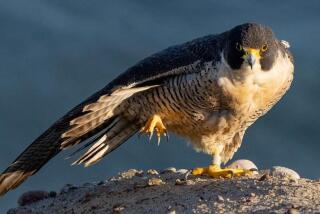Falcons Become Bird Dogs of Global Environmental Problems : Research: Tiny transmitters on two peregrines help scientists monitor hazards. The birds will be recaptured in the spring for more study.
- Share via
ANCHORAGE — A union of mini-technology and the migration of peregrine falcons is showing promise for scientists who want a better look at some of the planet’s biggest environmental ailments.
Mercury contamination at Brazilian gold mining operations. Rapid deforestation in South America, China and Southeast Asia. Decades of wanton industrial pollution in the former Soviet Union.
Learning more about these and other problems was among the goals when U.S. Fish and Wildlife Service biologists in July strapped satellite transmitters onto a pair of female peregrine falcons nesting on Alaska’s Yukon River.
The $2,700 transmitters, looking like science-fiction jet packs, were fresh from a Maryland design lab with the latest advances. They weighed less than an ounce, about as much as can be attached to a 2-pound female peregrine falcon.
Paul Howey, a British biologist turned gadget-head, built the matchbox-size devices. To do so, he thought small--much in the same way as the computer whizzes who shrunk mammoth mainframes down to pocket calculators.
After years of working as a bird migration researcher at Johns Hopkins University, he quit in 1991 to start a company, Microwave Telemetry Inc., dedicated to miniaturizing the smallest transmitters, then weighing about 3 1/2 ounces, to peregrine-falcon size.
“Engineers have been trying to develop this for years, but they’ve had trouble envisioning how to put it on the birds and what it has to stand up to,” he said.
Howey cut weight by using ultrasound and a microscope to weld wires to a tiny silicon chip and the chip in turn to a circuit board. The sensitive circuit was then hermetically sealed in nitrogen gas to protect it from moisture.
The electronics tipped the scales at three grams. A lithium battery to power the transmitter for a year added 16 grams, and the plastic housing, antenna and lightweight neoprene harness a combined nine grams.
Every four days the battery comes on and emits a signal picked up by a weather satellite circling the Earth. The satellite records the signal’s time and radio frequency and sends that information to a listening station at the Poker Flat Research Range, north of Fairbanks, Alaska, where computers figure out the peregrine falcon’s location.
Scientists say the peregrine falcon’s position at the top of its food chain--what it eats contains the accumulated toxins of all prey down the line--makes it a good gauge of ecological woes.
Proof of this came in the years after World War II, when widespread use of DDT and other pesticides, since banned in much of the world, damaged the peregrine falcon’s ability to reproduce and drove it to the endangered species list.
“But as one environmental threat goes down, others come up,” said Skip Ambrose, head of the Fish and Wildlife Service’s endangered species program in Alaska.
The bird has made a recovery since the early 1970s and now is a candidate for removal from the endangered species list. Ambrose says their numbers have tripled to about 600 in Alaska in the last 20 years, and increases have been even more dramatic elsewhere.
Peregrine falcons, found on every continent except Antarctica, are also valuable to scientists because they have long winter migrations and they return to the same wintering grounds year after year, and thus can be used to monitor changes there over time.
Those in the Western Hemisphere head from their northern nesting areas in the United States, Canada and Greenland as far south as Brazil and Argentina.
From banding thousands of peregrine falcons during the last 50 years, biologists know generally where the birds go for the winter, but they are not clear on the routes the birds take to get there, or how fast they travel.
The Yukon River peregrine falcons Ambrose outfitted with transmitters are filling in some of those gaps.
One started flying south on Aug. 31 and a week later was detected over the northern Great Plains. A map of its route shows a 3,800-mile straight arrow to the Everglades in southern Florida, where it has been since mid-September.
The other left Alaska on Sept. 6 and in a month traveled 4,400 miles, passing through the Canadian Rockies to North Dakota to Missouri and then south to Mexico’s Yucatan Peninsula and the east coast of Honduras. Although the bird has been idle for three weeks, Ambrose said he thinks that it may continue its migration to Brazil.
Ambrose also attached transmitters to two peregrine falcons in southern Utah that have been traced to Mexico’s west coast, and a pair outfitted in Virginia were in Cuba at last report.
Although the locaters have worked well for tailing the peregrine falcons, Ambrose says the true measure of success won’t come until the birds return to their nesting areas next spring.
Fish and Wildlife Service biologists have captured and banded about 3,000 peregrine falcons in Alaska in 20 years but have had little success in retrieving and testing them, Ambrose says.
The transmitter, he says, “is going to change everything. We’ll catch these birds next year and take measurements, blood samples and feather samples (to test for mercury and other accumulations), and then release them again.”
The goal is to build an information bank and work with countries where peregrine falcons go, both to protect the birds and monitor environmental changes.
“We haven’t had much contact with those countries. They don’t have a lot of money for research,” he said.
Next year’s plans call for expanding the transmitter project to 15 female peregrine falcons from Alaska.
More to Read
Sign up for Essential California
The most important California stories and recommendations in your inbox every morning.
You may occasionally receive promotional content from the Los Angeles Times.













